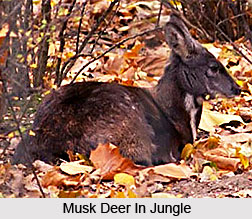 Musk Deer constitute one of the major endangered deer species in India as well as in the entire world. Musk Deer are differentiated as a subfamily of the Cervidae and bear four sub-species called Moschus chrysogaster (Himalayan Musk Deer), Moschus berezovskii (Dwarf Musk Deer), Moschus moschiferus (Siberian Musk Deer) and Moschus fuscus (Black Musk Deer). The Indian musk deer bears the tendency to be more secretive and they are easily seen either dwelling alone or in some groups, which comprises of about three members. Each of the group of Musk Deer consists of a mother along with her young ones. They can be visible during early morning, later parts of the evening and during night time. At the time of snowfall, Musk Deer become lethargic. They climb trees and use tree shrubs and moss as their food in order to survive.
Musk Deer constitute one of the major endangered deer species in India as well as in the entire world. Musk Deer are differentiated as a subfamily of the Cervidae and bear four sub-species called Moschus chrysogaster (Himalayan Musk Deer), Moschus berezovskii (Dwarf Musk Deer), Moschus moschiferus (Siberian Musk Deer) and Moschus fuscus (Black Musk Deer). The Indian musk deer bears the tendency to be more secretive and they are easily seen either dwelling alone or in some groups, which comprises of about three members. Each of the group of Musk Deer consists of a mother along with her young ones. They can be visible during early morning, later parts of the evening and during night time. At the time of snowfall, Musk Deer become lethargic. They climb trees and use tree shrubs and moss as their food in order to survive.
Physical Characteristics Musk Deer, Indian Animal
Indian Musk deer resembles the size of a medium-high dog and weigh about nine to eleven kilograms and are quite different from several other Indian deer. The hind legs of Musk deer are muscular and long with short forelimbs, weak and thin. The arched and small back makes it higher at the sacrum which helps the Musk Deer to take well-orgainzed jumps with the help of their hind legs. Both the male and the female musk deer do not possess antlers. The male Musk Deer possesses canines which stick downward out from the mouth and these are larger than those of the female Musk Deer. The new born musk deer`s coat is dark brown in colour which is covered with short and soft hair. They also bear white or yellowish spots on their coat. With the approaching of second winter for a young Musk Deer, it gets enveloped with a winter coat having coarse hair and almost no spots. The male musk deer possesses a musk pouch, located in between the naval and sex organ. Whenever the male wants to min the attention of a mate, it releases a scent which is there in the pouch.
 Food Habit
Food Habit
These are herbivores and are believed to consume more than one hundred and thirty species of plants. Musk Deer also eats a few lichens and mosses. During the months of winter, these animals chiefly eat arboreal lichens and few terrestrial bushy lichens. Some of their other food habits include coniferous needles, young shoots, leaves, bark of mountain ash, buds, aspens, willow, maple, bird cherry and honeysuckle. During summer months they eat herbaceous plants, including geranium, buckwheat, some grasses, and spirea acts as one of their major portion of diet.
Mating Behaviour of Musk Deer, Indian Animal
Musk Deer mates in the months of December and the mating time lasts for a period of three to four weeks. The period of gestation for the Musk Deer is between one hundred and eighty five and one hundred and ninety five days. The total number of offspring born is mainly one and it seldom reaches two. Hidden and safer places are selected for fawning and the offspring remain with the mother for two or more years.
The most prominent habitat of Indian musk deer is pockets with rock outcrops, which act as a place of shelter from their predators. With the approach of winter, musk deer migrate to steep slopes, abundant in coniferous trees. During the summer, they stay in valleys having forest rivers or near streams or some fields with suitable grassy vegetation. Swampy forests are not the favourable habitat of musk deer. Musk deer is counted among the most endangered species of deer. One of the prominent reasons behind this is that the Musk deer are largely killed for their musk. The major predators of the Musk deer are wolverine, lynx and the yellow-throated marten. Indian Musk deer is counted among the highly killed and endangered species in India.



















